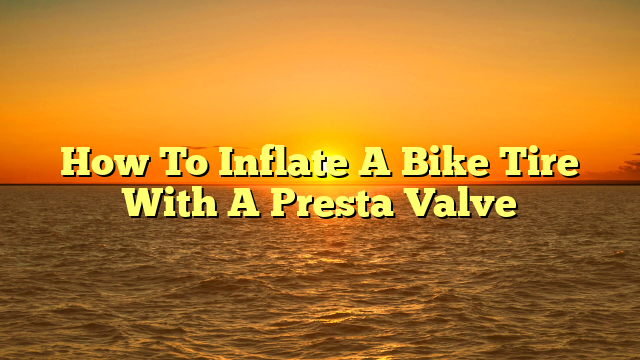Biking is an excellent way to stay active and explore the outdoors.
However, a flat tire can put a damper on your ride and leave you stranded.
To prevent this, it’s important to know how to properly inflate your bike tires.
If your bike has a Presta valve, you may be wondering how to fill it with air.
In this article, we will guide you through the step-by-step process of filling a bike tire with a Presta valve.
Presta valves are commonly found on road bikes and some mountain bikes.
They differ from Schrader valves, which are the more common valve type found on most bikes.
Presta valves are thinner and longer, with a threaded locking nut at the top.
They also have a smaller valve opening, which requires a specific pump head to inflate the tire.
Understanding the components of a Presta valve and the correct inflation process is crucial to prevent damage to the valve and ensure a safe and comfortable ride.
Table of Contents
- 1 Key Takeaways
- 2 Understanding Presta Valves and Their Components
- 3 Choosing the Right Pump for Your Presta Valve
- 4 Preparing Your Bike and Pump for Inflation
- 5 Loosening the Locking Nut on Your Presta Valve
- 6 Attaching the Pump Head to Your Presta Valve
- 7 Inflating Your Bike Tire to the Correct Pressure
- 8 Removing the Pump Head and Tightening the Locking Nut
- 9 Checking Your Tire Pressure and Enjoying Your Ride!
- 10 Frequently Asked Questions
- 10.1 What is the difference between a presta valve and a Schrader valve?
- 10.2 How do you know when your bike tire needs to be inflated?
- 10.3 Can you inflate a presta valve with a regular air compressor?
- 10.4 What should you do if the pump head doesn’t fit snugly onto the presta valve?
- 10.5 How often should you check the tire pressure on your bike?
- 11 Conclusion
Key Takeaways
- Choose the right pump for your Presta valve
- Loosen the locking nut on the Presta valve before inflating
- Inflate the tire gradually and check the pressure frequently
- Remove the pump head gently after inflation
Understanding Presta Valves and Their Components
The understanding of Presta valves and their components is crucial in properly filling bike tires with this type of valve.
Presta valves are commonly found on high-performance bicycles and are known for their narrow design.
They have a threaded shaft with a small nut at the top that holds the valve in place.
The valve stem is also thinner than the Schrader valve commonly found on car tires.
Understanding Presta valve maintenance is important to prevent valve issues like leaks and blockages from occurring.
Troubleshooting presta valve issues is necessary to identify and fix problems with the valve.
One common issue is that the valve may not release air when the pump is attached.
This can be due to the valve being closed.
To remedy this, unscrew the small nut at the top of the valve to open it.
Another potential issue is that air may leak out of the valve when the pump is removed.
This can be due to a loose or damaged valve core.
Tightening or replacing the valve core can fix this issue.
Overall, understanding the components and maintenance of Presta valves is crucial in maintaining proper tire pressure and preventing valve issues.
Choosing the Right Pump for Your Presta Valve
Selecting the appropriate pump is crucial when inflating a bicycle tire with a specific type of valve commonly used in high-performance bicycles.
Presta valves require a pump that can accommodate their narrow diameter and higher air pressure.
There are two main types of pumps that can be used to inflate a Presta valve: floor pumps and hand pumps.
Floor pumps are the most common type of pump used for inflating bicycle tires.
They are typically larger, more powerful, and have a stable base for easy pumping.
Floor pumps can inflate a tire quickly and efficiently, and they often come with a pressure gauge to ensure accurate inflation.
However, they can be bulky and not ideal for travel.
Hand pumps, on the other hand, are smaller, portable, and can be taken with you on rides.
They are ideal for emergency situations and quick top-ups, but they require more effort to inflate a tire and may not have a pressure gauge.
Overall, the choice of the pump depends on personal preference, convenience, and the type of riding you do.
Preparing Your Bike and Pump for Inflation
To ensure proper inflation of your high-performance bicycle, it is important to prepare both your pump and your equipment before beginning the process.
First, proper storage of your bike can help prevent damage to the valve stem and other parts of the bike.
Make sure your bike is stable and secure before attempting to inflate the tire.
Check the valve stem for any signs of damage or wear, such as cracks or tears.
If you notice any problems, replace the valve before attempting to inflate the tire.
Second, it is important to avoid common mistakes when inflating your tire.
One common mistake is over-inflating the tire, which can cause it to burst and lead to injury.
To avoid this, check the recommended pressure for your tire and use a pressure gauge to ensure the tire is inflated to the correct level.
Another mistake is inflating the tire too quickly, which can also cause damage to the valve stem.
Instead, inflate the tire slowly and steadily, checking the pressure frequently to ensure proper inflation.
By following these steps, you can ensure your bike tire is properly inflated for safe and efficient riding.
Loosening the Locking Nut on Your Presta Valve
Loosening the locking nut on a Presta valve is an essential step in inflating a high-performance bicycle tire.
To do this, you must first unscrew the valve cap and locate the locking nut at the base of the valve stem.
Use your fingers to turn the nut counterclockwise until it is fully loose.
Once the nut is loosened, you can press down on the valve stem to release any air pressure that may be in the tire.
This will make it easier to attach your pump and inflate the tire to the correct pressure.
It is crucial to use the proper technique when loosening the locking nut on a Presta valve.
Common mistakes include using pliers or other tools to loosen the nut, which can damage the valve and make it difficult to inflate the tire.
Additionally, it is important not to overtighten the nut when replacing it after inflating the tire.
Doing so can cause the valve to become stuck in the closed position, preventing air from entering the tire.
By following the correct technique and avoiding common mistakes, you can ensure that your Presta valve remains in good condition and that your high-performance bicycle tire is properly inflated.
Attaching the Pump Head to Your Presta Valve
The next step in properly inflating a high-performance bicycle tire involves attaching the pump head to the valve stem.
This step requires proper positioning of the pump head to avoid air leaks and ensure that the air is pumped into the tire.
Follow these steps to attach the pump head to your Presta valve:
- Unscrew the pump head nut counterclockwise until the head is open.
- Place the pump head onto the valve stem, making sure that it is straight and aligned with the valve.
- Push the pump head down onto the valve stem and lock it into place by screwing the pump head nut clockwise.
- Ensure that the pump head is attached securely to the valve stem by giving it a slight tug.
Proper positioning of the pump head and ensuring there are no air leaks is crucial in inflating a high-performance bicycle tire.
By following these steps, you can ensure that the pump head is attached securely and that there are no leaks in the valve stem.
Once the pump head is attached, you can proceed with inflating the tire to the recommended pressure level.
Inflating Your Bike Tire to the Correct Pressure
Achieving the appropriate pressure level is a crucial step in ensuring the optimal performance of your high-performance bicycle.
Proper tire pressure not only affects your bike’s speed and handling but also its safety and durability.
The importance of keeping your bike tires inflated to the correct pressure cannot be overstated.
Riding on underinflated tires can lead to increased rolling resistance, making it more difficult to pedal, and also increasing the risk of pinch flats, which can result in punctures.
Overinflated tires, on the other hand, can cause the tire to feel hard and unyielding, leading to a harsh and uncomfortable ride.
It can also increase the risk of a blowout, which can be dangerous.
However, many cyclists make common mistakes while inflating their tires.
One of the most common errors is not checking the current pressure before inflating.
It is essential to know the recommended pressure range for your bike tires and check the pressure using a gauge before adding air.
Another mistake is overinflating the tires.
It is crucial to inflate the tires gradually while checking the pressure frequently to avoid overinflation.
Lastly, it is essential to ensure that the pump head is tightly connected to the valve to prevent air leaks.
By avoiding these mistakes and inflating the tires to the correct pressure, you can ensure a smooth and safe ride, extend the life of your tires, and improve your bike’s overall performance.
Removing the Pump Head and Tightening the Locking Nut
To ensure proper air pressure retention and prevent air leaks, it is important to securely remove the pump head and tighten the locking nut after inflating the bicycle tire.
Removing the pump head involves gently pulling the lever or flipping the switch to release the valve.
It is important to hold the valve steady while removing the pump head to prevent any damage to the valve or the tube.
After the pump head has been removed, it is necessary to tighten the locking nut to prevent air leaks.
Here are three steps to follow to properly tighten the locking nut:
- Use a wrench to tighten the locking nut until it is snug against the valve stem.
- Do not over-tighten the locking nut as this can damage the valve stem.
- Check for air leaks by spraying a soapy solution over the valve stem.
If bubbles appear, it means that the locking nut needs to be tightened further.
By following these steps, cyclists can ensure that their tires are properly inflated and ready for a smooth ride.
Checking Your Tire Pressure and Enjoying Your Ride!
One of the most important things that a cyclist should do before going on a ride is to check their tire pressure.
Properly inflated tires provide a smoother and more efficient ride, while also reducing the risk of getting a flat tire.
Checking tire pressure is a simple yet crucial step that can greatly improve the overall cycling experience.
The benefits of proper inflation are numerous.
Properly inflated tires provide better grip and traction, making it easier to control the bike and navigate corners.
In addition, they reduce rolling resistance, which means that less effort is needed to maintain a certain speed.
Proper inflation also prevents premature wear and tear on the tires, which can prolong their lifespan and save money in the long run.
Therefore, it is essential to check tire pressure regularly and adjust it as necessary to ensure a safe and enjoyable ride.
Frequently Asked Questions
What is the difference between a presta valve and a Schrader valve?
Presta valve advantages include a smaller diameter and lighter weight, which reduces rotational weight and allows for higher pressures.
Schrader valve limitations include a larger diameter and heavier weight, which make them less suitable for high-performance applications.
Presta valve compatibility can be achieved with adapters, while Schrader valve alternatives include Dunlop valves and Woods valves.
How do you know when your bike tire needs to be inflated?
Determining when to inflate a bike tire is crucial for optimal performance and safety.
Signs of a deflated tire include a soft and spongy feel, decreased speed, and difficulty in handling.
Proper tire inflation provides benefits, such as improved traction, reduced rolling resistance, and longer tire life.
Can you inflate a presta valve with a regular air compressor?
Inflating a Presta valve with a regular air compressor requires the use of a Presta valve adapter.
Benefits of using a Presta valve over a Schrader valve include a smaller valve diameter, which can lead to less air leakage and a more secure connection.
What should you do if the pump head doesn’t fit snugly onto the presta valve?
If the pump head doesn’t fit snugly onto the presta valve, adjusting the pump head may be necessary.
One option is to use adapters to ensure a proper fit.
It’s important to ensure a secure fit to prevent air leakage and maintain tire pressure.
How often should you check the tire pressure on your bike?
Regularly checking tire pressure is crucial for optimal bike performance and safety.
The recommended frequency varies based on factors such as riding frequency, terrain, and tire type, but generally, checking before each ride or at least once a week is ideal.
Conclusion
The process of filling a bike tire with a Presta valve requires attention to detail and the right tools.
It begins with understanding the components of the valve and selecting the appropriate pump.
Preparing your bike and pump for inflation is also crucial to ensure a successful outcome.
Once you have loosened the locking nut on your Presta valve, you can attach the pump head and begin inflating your tire.
It is important to monitor the pressure of your tire during inflation and to remove the pump head and tighten the locking nut once you have reached the correct pressure.
Checking your tire pressure before each ride will help ensure a safe and comfortable cycling experience.
With these steps in mind, you can confidently fill your bike tire with a Presta valve and hit the road.







